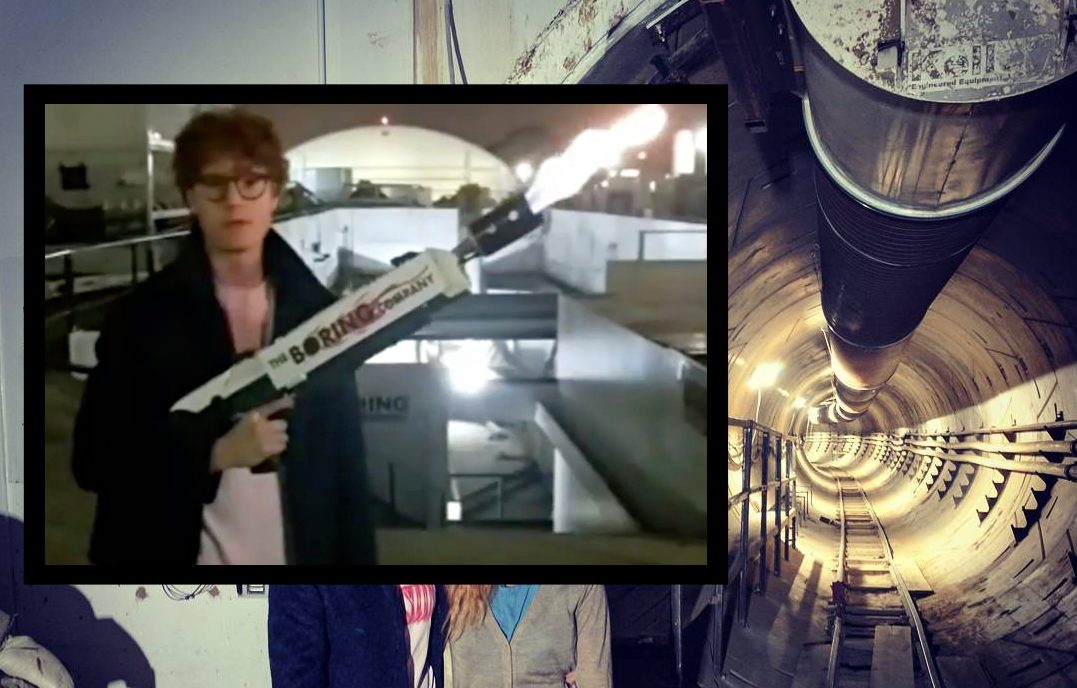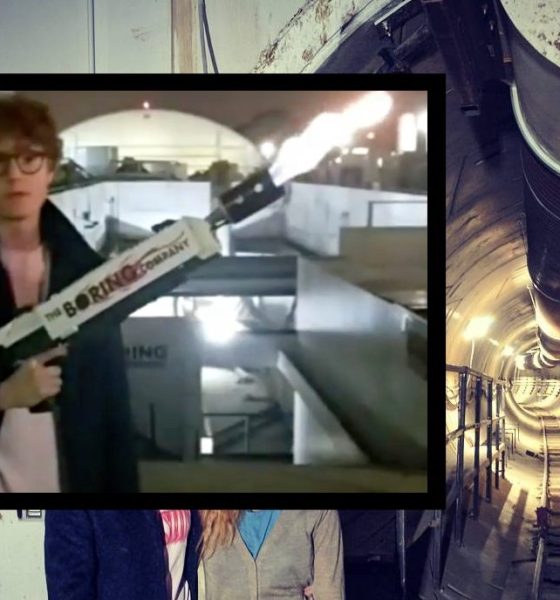

Lifestyle
Elon Musk’s Boring Company flamethrower apparently exists in real life
Back in December, Tesla CEO Elon Musk joked that after selling 50,000 Boring Company hats, the tunneling startup would start offering The Boring Co. flamethrower. The flamethrower joke never really died down, thanks in part to Musk’s constant mention of the allegedly “safe” product on his tweets. As recently revealed by one of Musk’s followers on social media, however, The Boring Company flamethrower actually exists, and it’s fully functional.
The Boring Co. flamethrower recently made a quiet debut on social media, after writer-musician D.A. Wallach posted a brief clip of himself holding and operating the fiery device while he toured the tunnels being dug by the Elon Musk-led firm. During the short clip, Wallach could be seen playfully talking to the camera while demonstrating the fiery capabilities of The Boring Co. flamethrower. As noted by an Instagram commenter on Wallach’s post, the device itself appears to be a modified CSI S.T.A.R. XR-5 Airsoft Rifle. Instead of firing rounds of BBs, however, The Boring Co. flamethrower fires a stream of red-hot flame.
https://www.instagram.com/p/BeHSiMmBazJ/?tagged=boring
Not long after Musk joked that his tunnel-digging venture would be selling the ‘safest flamethrower ever’, the Tesla, SpaceX and The Boring Co. CEO announced that ten lucky hat buyers would be selected at random to tour the Los Angeles tunnel system and drive the company’s Boring Machine. Based on the social media activity of the tech investor and musician-writer, it appears that Wallach could have been one of the lucky hat owners who was picked to win the fun prize, though it’s more likely that he was invited as a guest of Musk. It is still unknown, however, if Wallach did end up operating GoDot or Line-Storm during his tour.
I know it’s a little off-brand, but kids love it
— Elon Musk (@elonmusk) December 11, 2017
While Wallach’s Instagram updates seemed to be a simple upload featuring some shots of the Elon Musk-led firm’s operations, the image and clip that were posted on the social media platform do provide a rare look into the recent workings of The Boring Company. Among Elon Musk’s ventures, very little of what actually happens in the operations of the tunneling firm have been shared with the public. Based on Wallach’s social media upload, however, it seems like The Boring Co.’s tunnels, at least in the Los Angeles area, are already quite expansive.
As we mentioned in a previous report, Tesla and SpaceX board member Steve Jurvetson has expressed his full support for the tunneling firm’s venture, with the executive even stating that he personally likes The Boring Co,’s concept more than Hyperloop. According to Jurvetson, Elon Musk’s vision for the tunneling firm’s concept is more than feasible.
“I personally love the idea, in fact even more than the Hyperloop idea, of digging these tunnels. The inside I think that’s so powerful is that if you only envision electric vehicles in your tunnels, you don’t need to do the air handling for all carbon monoxide, carbon dioxide, you know, basically pollutants for exhaust. You could have scrubbers and a variety of simpler things that make everything collapse to a smaller tunnel size, which dramatically lowers the cost. The whole concept of what you do with tunnels changes.”
The company’s first route in Southern California is expected to run parallel to a section of Los Angeles’ notorious 405 freeway and consistent winner of “America’s worst freeways”. A statement made on The Boring Company’s website indicates that the route will work like a fast freeway, where electric skates carrying vehicles and people on pods on the main artery travel at up to 150mph. Upon successful completion of Phase 1, a Phase 2 route will extend into the outskirts of Los Angeles County and stretch from San Fernando Valley in the north to as far south as Long Beach airport.

Lifestyle
Tesla Model S Plaid battles China’s 1500 hp monster Nurburgring monster, with surprising results
There is just something about Tesla’s tuning and refinement that makes raw specs seem not as game-changing.

The Tesla Model S Plaid has been around for some time. Today, it is no longer the world’s quickest four-door electric sedan, nor is it the most powerful. As per a recent video from motoring YouTube channel Carwow, however, it seems like the Model S Plaid is still more than a match for some of its newer and more powerful rivals.
The monster from China
The Xiaomi SU7 Ultra is nothing short of a monster. Just like the Model S Plaid, it features three motors. It also has 1,548 hp and 1,770 Nm of torque. It’s All Wheel Drive and weighs a hefty 2,360 kg. The vehicle, which costs just about the equivalent of £55,000, has been recorded setting an insane 7:04.957 at the Nurburgring, surpassing the previous record held by the Porsche Taycan Turbo GT.
For all intents and purposes, the Model S Plaid looked outgunned in Carwow’s test. The Model S Plaid is no slouch with its three motors that produce 1,020 hp and 1,420 Nm of torque. It’s also a bit lighter at 2,190 kg despite its larger size. However, as the Carwow host pointed out, the Model S Plaid holds a 7:25.231 record in the Nurburgring. Compared to the Xiaomi SU7 Ultra’s record, the Model S Plaid’s lap time is notably slower.
Real-world tests
As could be seen in Carwow’s drag races, however, Tesla’s tech wizardry with the Model S Plaid is still hard to beat. The two vehicles competed in nine races, and the older Model S Plaid actually beat its newer, more powerful counterpart from China several times. At one point in the race, the Xiaomi SU7 Ultra hit its power limit due to its battery’s temperature, but the Model S Plaid was still going strong.
The Model S Plaid was first teased five years ago, in September 2020 during Tesla’s Battery Day. Since then, cars like the Lucid Air Sapphire and the Xiaomi SU7 Ultra have been released, surpassing its specs. But just like the Model Y ended up being the better all-rounder compared to the BYD Sealion 7 and the MG IM6, there is just something about Tesla’s tuning and refinement that makes raw specs seem not as game-changing.
Check out Carwow’s Model S Plaid vs Xiaomi SU7 drag race video below.
Lifestyle
500-mile test proves why Tesla Model Y still humiliates rivals in Europe
On paper, the BYD Sealion 7 and MG IM6 promised standout capabilities against the Model Y.

BYD is seeing a lot of momentum in Europe, so much so that mainstream media has taken every opportunity to argue that the Chinese automaker has beaten Tesla in the region. But while BYD sales this year in Europe are rising and Tesla’s registrations remain challenged, the raw capabilities of vehicles like the Model Y are difficult to deny.
This was highlighted in a 500-mile challenge by What Car? magazine, which showed that the new Tesla Model Y is more efficient, cheaper to run, and more reliable than rivals like the BYD Sealion 7, and even the nearly 400 KW-charging MG IM6.
Range and charging promises
On paper, the BYD Sealion 7 and MG IM6 promised standout capabilities against the Model Y. The Sealion 7 had more estimated range and the IM6 promised significantly faster charging. When faced with real-world conditions, however, it was still the Model Y that proved superior.
During the 500-mile test, the BYD nearly failed to reach a charging stop, arriving with less range than its display projected, as noted in a CarUp report. MG fared better, but its charging speeds never reached its promised nearly-400 kW charging speed. Tesla’s Model Y, by comparison, managed energy calculations precisely and arrived at each stop without issue.
Tesla leads in areas that matter
Charging times from 25% to 80% showed that the MG was the fastest at 17 minutes, while Tesla and BYD were close at 28 and 29 minutes, respectively. Overall efficiency and cost told a different story, however. The Model Y consumed 19.4 kWh per 100 km, compared to 22.2 for MG and 23.9 for BYD. Over the full trip, Tesla’s charging costs totaled just £82 thanks to its supercharger network, far below BYD’s £130 and MG’s £119.
What Car? Magazine’s testers concluded that despite BYD’s rapid sales growth and the MG IM6’s seriously impressive charging speeds, Tesla remains the more compelling real-world choice. The Model Y just offers stability, efficiency, and a proven charging infrastructure through its Supercharging network. And as per the magazine’s hosts, the Model Y is even the cheapest car to own among the three that were tested.
Watch What Car? Magazine’s 500-mile test in the video below.
Lifestyle
Tesla Cybertruck slapped with world’s least intimidating ticket, and it’s pure cringe
One cannot help but cringe and feel second-hand embarrassment at the idea of a person just driving around with a stack of these babies.

A Cybertruck parked at Stanford Shopping Center in California was recently hit with what might be the most try-hard piece of paper ever slipped under a wiper blade: a “fake citation” accusing the driver of supporting a “fascist car.”
The note, shared on X by Tesla staff program manager Ryan Torres, quickly made the rounds on X, where it quickly gained attention as an example of how not to protest.
The world’s least intimidating ticket
According to the citation, the supposed “violation” was “driving a fascist car.” The remedial action? Take the bus, call an Uber, or ride a bike. The note also dubbed Elon Musk a “chainsaw-wielding Nazi billionaire.” Now, protests against Tesla and Elon Musk have become commonplace this year, but one cannot help but cringe and feel second-hand embarrassment at the idea of a person just driving around with a stack of fake anti-Tesla/Musk citations.
Torres pointed out the irony himself in his post on X. Tesla currently employs over 140,000 Americans, and SpaceX has put the U.S. firmly back at the top of space technology. As Torres put it, maybe the person behind the world’s least intimidating ticket should “read a book on innovation before vandalizing” other people’s property.
Peak performative clownery
Not to mention that the fake ticket’s logic collapses under its own weight. EVs like the Cybertruck are literally designed to reduce emissions, not “destroy the economy.” If anything, Tesla has bolstered the United States’ economy by fueling jobs in engineering, manufacturing, and clean energy. It’s not the first time a Tesla has been the target of vandalism or politically charged notes, but this one stands out for sheer cringe value.
Torres summed it up neatly: “Peak clownery.” On that point, at least, the citation earns full marks. In a way, though, perhaps cringe fake tickets are not as bad as the literal firebombs that were being thrown at Tesla stores and cars earlier this year because some critics were gleefully misinformed about Elon Musk.








